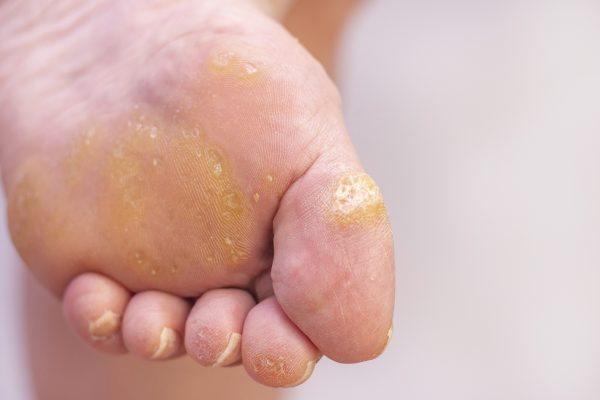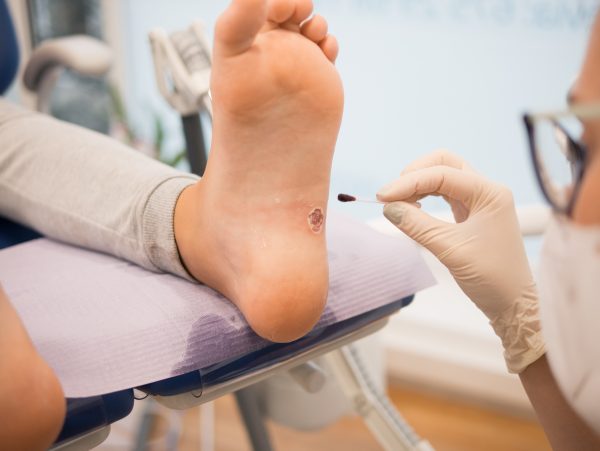From bumps in between your toes to sores on your lower pads, hard, grainy growths— known as foot warts or plantar warts— are not only ugly, they’re also painful. The good news is that plantar warts often go away on their own. However, it might take up to two years. Plus, if you don’t remove the wart on your foot properly, there’s a chance it could grow back.
With how common foot warts are, it can be difficult to know what they truly are and how to get rid of them once and for all. Today we’ll discuss whether or not foot warts are contagious, how they are different from corns, and safe foot wart removal options to keep your feet dancing.
Are Foot Warts Contagious? What Are They Anyway?
These tiny tormentors are caused by a human papillomavirus (HPV) infection in your feet, usually the soles and between your toes. While foot warts are technically not dangerous to your health, they rub on your shoes and can be tender, making standing or walking miserable.
The type of HPV that is responsible for causing foot warts is not very contagious, so you may not “get warts” even if you come in direct contact with them. However, you could develop warts if you walk barefoot in warm, moist places such as near swimming pools or in locker rooms.
Get a Diagnosis First: Plantar Warts vs. Corns
You have bumps or growths on your feet, but are you sure they’re warts? Plantar warts are often mistaken for corns or blisters, which can take a similar shape and also cause discomfort. In some cases, you can tell the difference between a plantar wart vs. a corn because the corn will have a center core of dense, hard skin. In contrast, foot warts often have brownish dots on the lump.
However, since warts can grow inward in the presence of calluses (see picture below), they can also be easily confused with other foot conditions. If needed, a podiatrist can examine a sample of the bump or lump for a clear diagnosis.

Removing Warts on Your Foot Takes Time
If you’re sure it’s plantar warts, the next step is coming to terms with the treatment timeline.
Most methods for removing foot warts require several treatments, stretched over time. It’s not a “slice it off and move on” kind of situation. Foot wart removal treatments take several weeks or more to be effective, according to self-care advice given by The American Academy of Dermatology.
With this in mind, set the expectation that foot wart treatment is a long game. But when done right, it can foster long-term results— meaning a lesser chance of recurrence.
Foot Wart Removal at Home & Other Options
Many of our patients like to know their options for controlling their warts at home before seeking over-the-counter or professional removal options.
How To Remove a Wart on the Foot at Home
Two big at-home remedies for foot warts are tea tree oil and apple cider vinegar. While neither can be directly linked as an effective treatment over long-term trials, both have been studied for their healing properties.
Tea Tree Oil: There is some research that the application of tea tree oil can be successfully used for foot wart removal. Keep in mind that many of the articles analyzed are over a decade old, so the evidence may not be reliable.
Apple Cider Vinegar: the acids in the vinegar may help to break down the wart’s tissue. Using apple cider vinegar to treat foot warts is inconclusive, but for those interested in home remedies, it might be worth a try.
Before trying any at-home treatments for plantar warts, we highly recommend consulting your doctor, dermatologist, or foot care specialist. Without proper counsel, you could mistakenly damage your foot tissue. With oils, for instance, every brand is different. Some oils cannot be applied directly to the skin without diluting or being used with a carrier oil. This is just one example of why it’s important to do your research or get professional advice before trying to remove the wart on your foot at home.
Over-the-Counter Wart Treatments
There are a number of over-the-counter treatments that you can get at your pharmacy without a prescription to self-treat foot warts.
Salicylic Acid Pads & Ointments: This type of acid is used commonly in acne treatments, wherein it breaks down dead skin cells. While you can purchase pads with the acid to place over a wart, most OTC wart creams help to shed the skin around your warts gradually. They are also ideal for those with many warts, as they can be applied over a general area. In contrast, the pads need to be placed directly on the wart alone since the acid can damage healthy skin with an acid “burn.”
Healthline recommends applying OTC wart ointment to your plantar warts twice a day. Remember, it could take several weeks before seeing results.
Freezing Sprays: Some opt for chilling sprays for a “quicker” turnaround time, sometimes eliminating foot warts in up to six weeks.
Freezing sprays work by applying a liquid nitrogen mixture over the wart, which creates a blister-like injury. Once your body naturally heals the blistered damage over the course of a week or so, the hope is that part of the wart will go away with it. This treatment is sometimes repeated a few times until the wart fully falls away.
Professional Foot Wart Removal
Sometimes plantar warts can be persistent, holding up against home remedies or OTC treatments and requiring a professional touch.
In these cases, a podiatrist may suggest the following for permanent foot wart removal:
- Prescription-strength wart medications
- Cryotherapy (like the OTC freezing sprays but more effective)
- Immune therapy
- Surgical removal
- Laser treatment
The right podiatrist will work with you to make a treatment plan that will get the job done while keeping you and your feet as comfortable as possible. In some cases, it may be possible for the foot care specialist to get rid of your warts in as little as five days.

Thwart the Warts With Professional Help
If you’ve tried natural home remedies or over-the-counter solutions for foot wart removal and nothing seemed to work, it might be time for professional care.
A podiatrist can not only properly diagnose your condition and treat warts, but they can also counsel you on the best practices for keeping them away in the future.
If you’re ready to kick your foot warts to the curb, schedule an appointment with The Foot & Ankle Group today.
Categorized in: Blog
Comments are closed